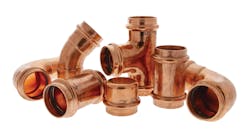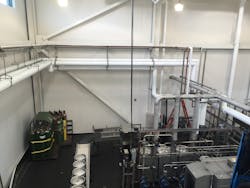Latest from Piping
Sponsored
Boasting names like “Furious”, “Xtra”, “Axe Man” and “Hell”, the beers crafted by Surly Brewing Co. capture the spirit that personifies America’s upper Midwest. One of the nation’s fastest growing micro-breweries with headquarters in Minneapolis, MN, Surly Brewing Co. brews seasonal and year-round beers. Is anyone thirsty, yet?
Every brew master worth his or her hops knows good beer and good processes go together. Precision processes and careful attention to ingredients used in crafting each beer are critical. So is the insulating process that channel processes through a network of water lines, steam lines, boiler feeding systems, heat exchangers and glycol chilling systems to process and store the final product.
From blasting to brewing
Built on the site of a former abrasives business, the brewery’s mechanical systems required an overhaul. Elite Insulation insulated the pipes that feed the boiler and drive brewing processes. For nearly 20 years, Elite Insulation has built a reputation in the food and beverage sector, providing mechanical insulation solutions to restaurants, schools, hospital and food service systems and even cheese plant—in addition to other industrial and commercial clients.
Since 2012, Elite Insulation has become the brewery’s longest running contractor partner. Whether a new install or a retrofit, Elite Insulation owner, Brooks Holmgren says micro-breweries—and other food and beverage facilities—require a customized approach when it comes to specifying and installing mechanical insulation for to optimize results. Following are best practices Holmgren advises for insulation when installing insulation in the brewery/food environment:
Best Practice #1 – Start with the Safety Culture First: Hazard assessment is always critical anytime the product produced is consumed by people. Areas to evaluate include material handling, chemical safety and kettle boil-over risk. Managing moisture and thermal performance are also critical.
Elite Insulation recommended a mechanical pipe insulating material that would maximize R-value and minimize condensation risk. Avoiding materials that support mold formation and proliferation was a priority. “Ingredients in a food environment have to be protected, especially when it comes to brewing beer, where key ingredients including hops and yeast need to be in carefully controlled environments,” Holmgren says. The previous insulation in the space was protected with a paper jacketing. Elite wanted a jacket that would look clean, wipe down easily, stay sealed and avoid mold and mildew. The first priority was to minimize the risk of any surface providing a breeding ground for mold and mildew to proliferate.
Owens Corning® SSL II® with ASJ Max Fiberglas™ Pipe Insulation replaced the stripped-off former pipe insulation. The insulation’s plastic/polymer jacket is smooth, durable, and wrinkle-resistant. Most importantly, it does not support mold or mildew growth, even in humid environments. And because jobsite efficiency also matters, the flex core sizes compress over pipes and fittings, saving up to 16 percent in install time by eliminating the need to filet.
Best Practice #2 – Respect the Environment: Great beer demands extreme hot and cold temperatures. Heating and cooling systems, water supply and drainage components must work together to manufacture the final product.
Operations must also stay clean and pristine. Consumers are increasingly concerned about how their food is produced and how the beer they drink is made. Prior to the global pandemic, public tours at Surly’s Minneapolis location allowed visitors to experience the brewhouse, fermentation cellar, packaging hall, and perhaps most importantly, the finished product. Keeping the contracting area clean and protected contributes to a safety and cleanliness culture on the jobsite.
Best Practice #3 – Manage Moisture: High humidity inside the brewing environment can support water-vapor transmission, allowing insulation to get wet. Properly installed insulation helps protect equipment from corrosion damage caused by moisture and supports the efficient operation of the system. Moisture condensation presents a risk for mold and mildew as well as an opportunity for moisture to oxidize on pipes, presenting a corrosive threat that damages expensive equipment used in the brewing process.
Mold, leaks and condensation can easily ruin a batch of beer during the brewing process so it’s critical to keep moisture out of the brewhouse. Elite Insulation’s products keep the contaminants out, glycol temperatures consistent and supports efficient cooling processes.
Best Practice #4 – Appearance and sanitation matter: Elite Insulation team specified an insulation with a protective polymer jacket that could be easily wiped down, protecting the material not just from normal particulates in the air, but against spills.
On-site cooking at the location demands materials can easily be wiped clean. The polymer jacket on the insulation allows for the insulation to be wiped off, maintaining cleanliness.
Locations where food is served require contractors to “plastic things off” during the install process. At Surly, the advanced double adhesion on the Max Fiberglas insulation provided the owner and project engineer with confidence that the material would seal and stay sealed with a closure system that provides adhesive on both sides of the jacketing for superior adhesion. The design eliminates the need to staple the jacket shut, saving labor and material costs while giving Surly’s the confidence that the closure will stay sealed and avoid costly callbacks.
Best Practice #5 – Respect the hot and cold of chemistry: After the grains are crushed, they are steeped in a mash where hot water turns mash into starch. Next, the starch is converted into a simple sugar called “wort.” As insulated lines transport steam to the kettle, they help improve efficiencies by regulating temperature. In the brewing business, what’s hot should not stay hot forever, so a heat exchanger using more insulated lines rapidly drops the temperature, exchanging the heat for a chilled effect. At this point, yeast is introduced again. During this phase, the temperature must be carefully modulated to protect the integrity of the end product. Brew masters are experts at adjusting temperatures to create different flavors and give each beer its unique taste personality. Glycol running between designated areas of a tank during the fermentation process helps further regulate the temperature. The glycol lines are covered with insulation to help manage moisture and control temperature.
Best Practice #6 – Pivot as needed: Just as brew masters are adept at adjusting ingredients to achieve nuances with a beer’s flavor, insulating contractors must often navigate unexpected surprises on the job. For example, Holmgren discovered the valves were not properly opening and closing to control the flow of glycol. Holmgren developed, built and installed new valve extensions that would support the stainless-steel equipment and perform reliably over a long time period.
Best Practice #7 – Keep owners informed: Communication between the insulating contractor, the general contractor and building owner is essential when anything unexpected occurs. “You don’t want to create drama, but the minute something significant comes up, it needs to be noted,” says Holmgren. During the insulation installation process, Holmgren worked closely with the owner, head brewer and building engineer on incremental strategies to make the process go as smoothly as possible; for example, selecting the right style and placement of hangers in the system. When the job was completed, a final walk-through provided an opportunity to review the work and serve as a final quality assurance step. Simply checking off items on a list is not enough according to Holmgren. “Always ask if the project meets expectations and if the owner is satisfied and happy with the work,” he advises. “Never assume.”
Best Practice #8 – The customer comes first: Contractors face many challenges when balancing project deadlines and coordinating logistics among multiple suppliers on a jobsite. But among all of these competing priorities, Holmgren says it’s important to remember the customer always comes first. “Sometimes it’s necessary to halt work on a project or idle a crew in the interest of making things easier for the customer,” he says. “The customers processes and business need to come first.”
By focusing on the eight steps above, insulation contractors can “get it right the first time” leading to referrals and repeat business.




